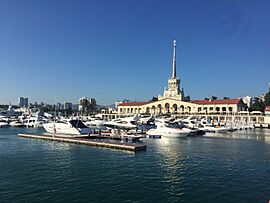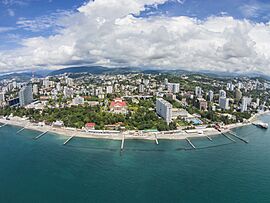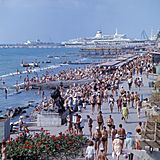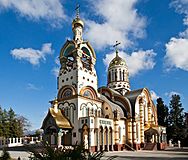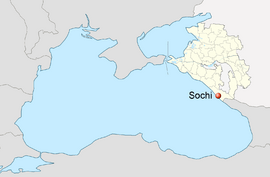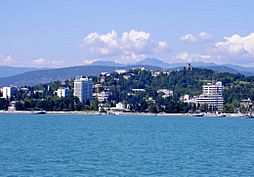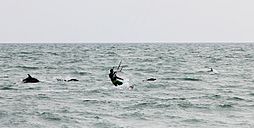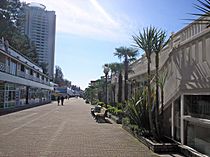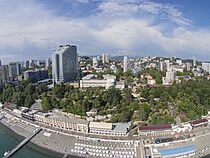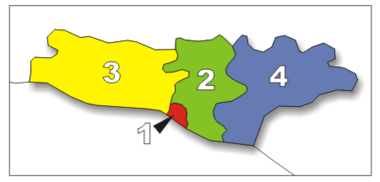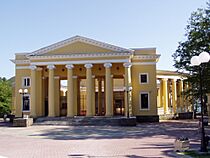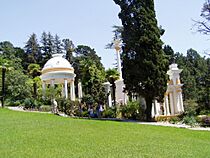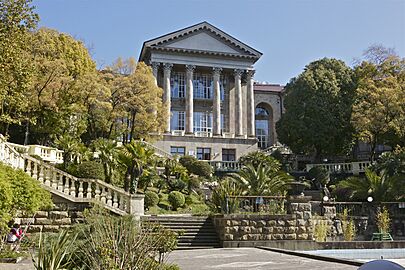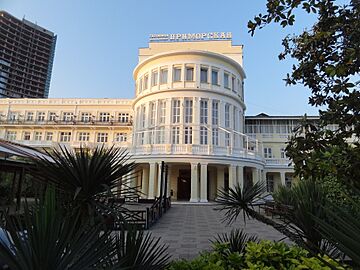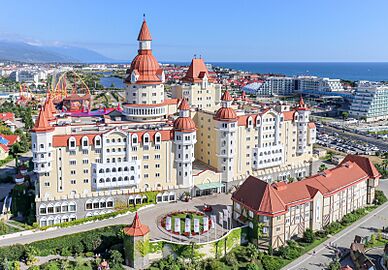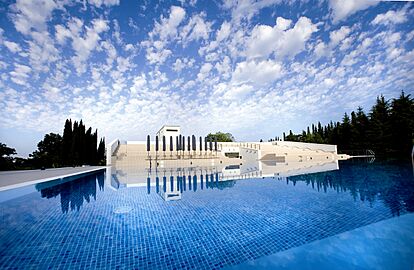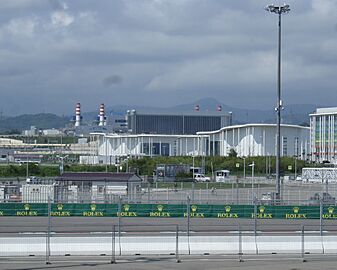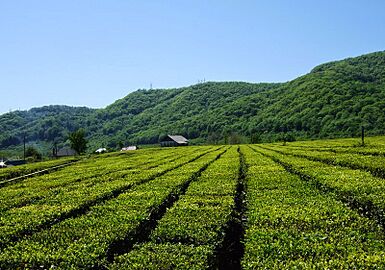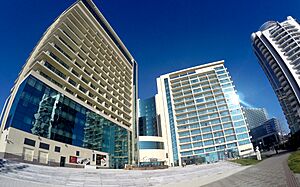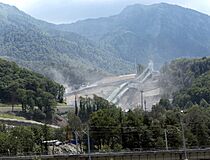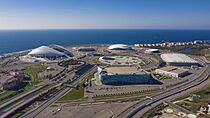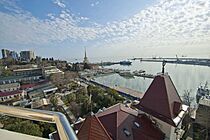Sochi facts for kids
Quick facts for kids Sochi (English)Сочи (Russian) |
|
|---|---|
| - City - | |
| [[File:
From top: Port of Sochi, Sochi Park, Winter Theatre, Sochi Olympic Park, Adler Railway Station
|250px]]Bird's-eye view of Sochi |
|
|
|
|
| Administrative status | |
| Country | Russia |
| Federal subject | Krasnodar Krai |
| Administratively subordinated to | City of Sochi |
| Municipal status | |
| Urban okrug | Sochi Urban Okrug |
| Mayor | Alexey Kopaigorodsky |
| Representative body | City Assembly |
| Statistics | |
| Area | 176.77 km2 (68.25 sq mi) |
| Population (2010 Census, preliminary) |
343,334 inhabitants |
| - Rank in 2010 | 52nd |
| Population (2024 est.) | 444,989 inhabitants |
| Density | 1,942/km2 (5,030/sq mi) |
| Time zone | MSK (UTC+04:00) |
| Founded | 1838 |
| Postal code(s) | 354000, 354002–354004, 354008–354010, 354013, 354014, 354018, 354019, 354022, 354024, 354025, 354030, 354031, 354033, 354036, 354037, 354039, 354053–354055, 354057, 354059, 354061, 354065–354068, 354071, 354073, 354084, 354099, 354200, 354202–354214, 354216–354218, 354220, 354226, 354231, 354233, 354299, 354340, 354346, 354348, 354349, 354354, 354355, 354364, 354380, 354382, 354383, 354399, 993501 |
| Dialing code(s) | +7 862 |
| Official website: http://sochiadm.ru/ | |
Sochi (Russian: Сочи, meaning "seaside") is Russia's largest resort city. It is located on the Sochi River along the Black Sea in Southern Russia. The city has about 466,078 residents. The Greater Sochi Area is very long, stretching about 145 kilometers (90 miles). This makes it the longest city in Europe.
Sochi was the host city for the 2014 Winter Olympics and 2014 Winter Paralympics. The nearby Rosa Khutor ski area hosted many of the Olympic events. Sochi also hosted the Formula 1 Russian Grand Prix races from 2014 to 2021. In 2018, it was one of the cities that hosted games for the 2018 FIFA World Cup.
Contents
What's in a Name?
The name "Sochi" (Сочи) comes from the Circassian word "Ş̂açə". This word is from the Ubykh-Circassian "Ş̂uaça". It combines two Ubykh words: "шъуа" (sea) and "ча" (side). So, it means "Seaside" or "coast". Some people also think the name might come from the Georgian word for "fir tree," which is "soch'i" (სოჭი).
A Look Back: Sochi's History
Colchis 13th century BC–63 AD
![]() Achaemenid Empire 511 BC–330 BC
Achaemenid Empire 511 BC–330 BC
Kingdom of Pontus 111 BC–62 BC
![]() Roman Empire 62 BC–337 AD
Roman Empire 62 BC–337 AD
Kingdom of Lazica 337–697
![]() Byzantine Empire 697–786
Byzantine Empire 697–786
![]() Kingdom of Abkhazia 778–1008
Kingdom of Abkhazia 778–1008
![]() Kingdom of Georgia 1008–1490
Kingdom of Georgia 1008–1490
![]() Mongol Empire 1242–1259
Mongol Empire 1242–1259
![]() Principality of Abkhazia 1491–1829
Principality of Abkhazia 1491–1829
![]() Ottoman Empire 1578–1829
Ottoman Empire 1578–1829
![]() Circassia 1829–1864
Circassia 1829–1864
![]() Russian Empire 1864–1917
Russian Empire 1864–1917
![]() Russian Republic 1917–1918
Russian Republic 1917–1918
![]() Russian Soviet Federative Socialist Republic 1918
Russian Soviet Federative Socialist Republic 1918
![]() Georgian Democratic Republic 1918–1919
Georgian Democratic Republic 1918–1919
![]() South Russia 1919–1920
South Russia 1919–1920
![]() Russian Soviet Federative Socialist Republic 1920–1991
Russian Soviet Federative Socialist Republic 1920–1991
![]() Russian Soviet Federative Socialist Republic 1922–1991
Russian Soviet Federative Socialist Republic 1922–1991
![]() Russian Federation 1991–present
Russian Federation 1991–present
How Old is Sochi?
Long ago, different groups like the Zygii people lived here. Later, the area was part of Georgian kingdoms like Lazica and Abkhazia. They built churches in the area. These Christian settlements were sometimes destroyed by invaders like the Mongols. You can still see parts of an 11th-century Byzantine church in the Loo Microdistrict.
Between the 13th and 15th centuries, traders from Genoa (Italy) set up trading posts here. From the 14th to the 19th centuries, local tribes like the Abkhaz and Ubykh controlled the region. They traded with the Ottoman Empire.
Becoming Part of Russia
Russia took control of this coastline in 1829 after a war. However, the local Circassians resisted. In 1838, Russia built a fort called Alexandria at the mouth of the Sochi River. This fort was part of a chain of forts to protect the area.
The last battle of the Russo-Circassian War happened in 1864. After this, the Dakhovsky fort was built where the old fort stood. This marked the end of the war, and the area became part of the Russian Empire.
Sochi in Soviet Times
During the Russian Civil War, there were fights in the area. Eventually, Sochi became Russian territory. In 1923, a railway was built along the coast. This railway is still important for transportation today.
Joseph Stalin, a leader of the Soviet Union, loved Sochi. He had his favorite vacation home (dacha) built here. During his time, many grand buildings were constructed, like the Rodina and Ordzhonikidze sanatoriums. Sochi continued to grow as a popular resort until the Soviet Union ended.
Sochi Today
After Russia lost access to resorts in Crimea in 1954, Sochi became Russia's main summer capital. In 1961, the city limits were expanded to create "Greater Sochi," which stretches for 140 kilometers (87 miles).
In 2005, Russia won the bid to host the 2014 Winter Olympics in Sochi. The country spent a lot of money, about $51 billion, to prepare for the games. In 2019, a new area called Sirius was created near Sochi. It is now a special federal territory.
Where is Sochi Located?
Greater Sochi is very long, stretching about 145 kilometers (90 miles) along the Black Sea coast. It is about 1603 kilometers (996 miles) from Moscow.
Sochi shares borders with other districts in Russia and with Georgia/Abkhazia to the southeast. The Black Sea is to its southwest.
Most of Sochi's people live in a narrow strip along the coast. This area is divided into smaller parts called microdistricts. Some of the largest are Lazarevskoye, Loo, Dagomys, central Sochi, Khosta, Matsesta, and Adler.
The city is built on the slopes of the Western Caucasus mountains, which go down to the Black Sea. Many rivers cut through these slopes, like the Mzymta and the Shakhe. The Psou River forms the border with Abkhazia.
A large part of the city is within the Sochi National Park. The northeastern part is also home to the Caucasian Biosphere Reserve, a World Heritage Site.
What's the Weather Like?
Sochi has a humid subtropical climate. This means it has mild winters and warm summers.
- In winter (December to March), the average temperature is about 11°C (52°F) during the day.
- In summer (May to October), the average temperature is about 24°C (75°F) during the day.
- The city gets about 1700 mm (67 inches) of rain each year.
- Sochi is on the same latitude as Nice, France, but cold winds can make winters a bit cooler.
Famous Places and Sights
Sochi is known for being a subtropical resort city. About two million people visit Greater Sochi every summer. It hosts the annual "Kinotavr" film festival.
The Caucasus Nature Reserve, a UNESCO World Heritage Site, is just north of the city. Sochi also has the most northern tea plantations in the world.
How is Sochi Organized?
Sochi is a "City of federal subject significance." This means it's an administrative unit, like a district. It includes the city of Sochi, one urban-type settlement (Krasnaya Polyana), and 79 smaller rural areas.
For local government, it's called the "Sochi Urban Okrug." Sochi is divided into four main city districts:
- Tsentralny City District (central Sochi)
- Lazarevsky City District
- Khostinsky City District
- Adlersky City District
Tsentralny City District is the smallest in area but has the most people. The other three districts are larger in size.
|
Central Sochi: Tsentralny City District
This district is the heart of Sochi. It covers 32 square kilometers (12 sq mi) and had 137,677 people in 2010. Some important places here are:
- Michael Archangel Cathedral: A church built between 1873 and 1891. It honors the end of the Caucasian War.
- Archangel Column: A red-granite column put up in 2006. It remembers Russian soldiers who died in the Caucasian War. It has a bronze statue of Sochi's patron saint, Michael the Archangel.
- Sochi Arboretum: A large botanical garden with tropical trees from many countries. It also has the Mayors Alleé, an avenue of palm trees planted by mayors from around the world.
- The Tree of Friendship: A special citrus tree planted in 1934. Many different types of citrus from other countries have been grafted onto it as a symbol of friendship.
Lazarevsky City District
This district is northwest of the city center. In 2010, it had 63,894 people. It is the largest district by area, covering about 1744 square kilometers (673 sq mi). It includes several smaller areas:
- Lazarevskoye: About 59 km (37 mi) from the city center. It has a delphinarium and old churches. It was founded as a Russian military post in 1839.
- Loo: About 18 km (11 mi) from the city center. It has the ruins of a medieval church from the 8th century.
- Dagomys: Also about 18 km (11 mi) from the city center. It is known for its botanical garden and tea plantations. Bocharov Ruchey, a country home for the President of Russia, is nearby.
- Golovinka: A historic place at the mouth of the Shakhe River. It was once a border between tribes. A fort was built here in 1838.
Khostinsky City District
This district is southeast of the city center. It covers about 374 square kilometers (144 sq mi) and had 65,229 people in 2010. Many small rivers run through it, giving names to areas like Matsesta and Khosta.
Adlersky City District
This is the southernmost district, close to the border with Abkhazia. It covers 1352 square kilometers (522 sq mi) and had 76,534 people in 2010. It used to be a separate town.
This district has natural wonders like the Akhshtyr Gorge, with a cave showing signs of ancient human life. The mountain part of the district has remote villages and the ski resort of Krasnaya Polyana. This resort hosted the 2014 Winter Olympics events. There is also a trout fishery and a breeding center for great apes here.
Who Lives in Sochi?
| Historical population | ||
|---|---|---|
| Year | Pop. | ±% |
| 1897 | 1,352 | — |
| 1926 | 10,433 | +671.7% |
| 1939 | 49,813 | +377.5% |
| 1959 | 81,912 | +64.4% |
| 1970 | 224,031 | +173.5% |
| 1979 | 287,353 | +28.3% |
| 1989 | 336,514 | +17.1% |
| 2002 | 328,809 | −2.3% |
| 2010 | 343,334 | +4.4% |
| 2021 | 466,078 | +35.8% |
| Source: Census data | ||
Most people in Sochi are Russian (about 70%). There is also a large Armenian community (about 20%). Many Armenians in Sochi are descendants of people who came from Turkey in the late 1800s. Others came from Georgia and Armenia.
| Year | Total population | Urban | Russians | Armenians | Ukrainians | Georgians |
|---|---|---|---|---|---|---|
| 1897 | 1,352 | N/A | 37.9% | 6.0% | 19.9% | 17.1% |
| 1992 | 369,900 | 322,400 | 68.7% | 14.2% | 5.9% | 1.5% |
| 2002 | 397,103 | 332,778 | 67.5% | 20.2% | 3.7% | 2.3% |
| 2010 | 420,589 | 347,932 | 69.92% | 20.09% | 2.29% | 2.03% |
| Source, unless otherwise marked: | ||||||
Religions in Sochi
Christianity came to the Sochi region in the Middle Ages. Before 1829, the area was quite isolated. Some Sunni Muslim Shapsugs (part of the Circassian nation) lived around Tkhagapsh. The Circassians became Muslims in the 17th century.
Today, Sochi is mostly a Christian city. However, there are about 20,000 Muslims (5% of people) living there. Most of them are Adyghe, but there are also Turks and Tatars.
A mosque was built in 2008 in the Bytkha area. There is also an older mosque about 40 km (25 mi) north of the city center.
Sochi has about thirty Russian Orthodox churches, with St. Michael's being the largest. There are also two monasteries and two Catholic churches. The Armenian community has about ten churches.
Sochi's Economy
| Year |
|
|---|---|
| 2014 |
136
|
| 2015 |
150
|
| 2016 |
170.8
|
| 2017 |
191.3
|
Sochi is an important economic center in Russia. Its economy relies on trade, construction, resorts, and tourism. In 2015, retail trade made up 59% of the economy, construction 15%, and resorts/tourism 11%.
Sochi is a very popular place for tourists and an important financial center. Over the last 10 years, more than 1.1 trillion rubles have been invested in the city's economy. In 2017, large businesses in Sochi made over 191.3 billion rubles.
In 2010, Sochi was ranked as the best Russian city for quality of life. In 2012, Forbes magazine named it the top city for business in Russia. Experts noted its fast growth and good environment.
Tourism in Sochi
Tourism is a huge part of Sochi's economy. In 2016, over 5.2 million tourists visited the city. This was 5.9% more than in 2015. Hotels in Sochi were about 77% full on average throughout the year.
Tourism brings a lot of money to Sochi. In 2015, tourism made about 30 billion rubles for the city. This shows how important visitors are to Sochi's success.
Trade and Services
Sochi has many shops and businesses. In 2016, retail trade made 57.2 billion rubles. There are 8,769 consumer businesses in the city. These include 5,013 retail stores, 1,450 restaurants, and 1,083 service businesses.
The amount of trade per person in Sochi is much higher than the average in Russia. This is because many tourists visit and people in Sochi earn good wages. Tourists contribute about 48% of the city's retail sales.
Industry and Farming
In 2016, industrial businesses in Sochi shipped 19.4 billion rubles worth of goods. Energy, gas, and water distribution made up a large part of this. Big companies like Adler TPP and Sochinskaya TPP are important here.
Most of Sochi's manufacturing industry is about food production. Large food companies include the Sochi meat-packing plant and bakeries. There are also farms that raise trout and quails.
Sochi also produces agricultural products like vegetables, citrus fruits, and flowers. It is one of the few places in Russia where tea is grown. Several companies, like Dagomyschay and Matsesta tea, grow and process tea.
Learning in Sochi
Sochi has over 70 secondary schools. It also has its own universities and colleges, which are important for the whole country.
Some of the main higher education institutions are:
- Sochi State University
- Russian International Olympic University
- Sochi Institute of Peoples' Friendship University of Russia
- International Innovation University
There are also many colleges for specialized training, like the College of Economics and Technology and the Medical College.
Science and Research
Sochi is important for Russian science because of its unique climate. It's the only subtropical area in Russia. This makes it a great place for research in:
- Botany (study of plants)
- Medicine
- Coastal construction
Sochi has several important research centers, such as the Sochi Research Center of the Russian Academy of Sciences. It also has institutes for medical research, forestry, and floriculture (flower growing).
Sports in Sochi
Sochi is a city that loves sports!
Sports Facilities and Teams
A local tennis school in Sochi has produced famous players like Maria Sharapova and Yevgeny Kafelnikov. The city's warm climate makes it a good place for sports training.
Sochi is home to the football team PFC Sochi, which plays in the Russian Premier League. It also has the ice hockey team HC Sochi, which plays in the Kontinental Hockey League.
The 2014 Winter Olympics and Paralympics
The ski resort of Roza Khutor in Krasnaya Polyana hosted the alpine and Nordic events for the 2014 Winter Olympics.
In 2007, Sochi was chosen to host the 2014 Winter Games. This was the first time Russia hosted the Winter Olympics and Paralympics. A lot of money was spent to build and improve sports facilities and infrastructure. The cost was about $51 billion.
Building for the Games
Huge construction projects took place to get Sochi ready. The electrical power system was upgraded. New power plants and transmission lines were built. This increased the power supply for the Olympic facilities.
Other Sports Events


The Silk Way Rally, a famous car race, had a stage in Sochi in 2010.
Sochi also hosted the Formula One Russian Grand Prix races from 2014. However, due to recent events, Sochi is not allowed to host these races anymore.
The World Robot Olympiad took place in Sochi in 2014. The 2014 World Chess Championship was also played here. The Fisht Olympic Stadium hosted 2018 FIFA World Cup football matches.
Getting Around Sochi
Public transport in Sochi mainly uses buses and taxis. The city is served by the Adler-Sochi International Airport.
There are also two funiculars (cable railways that go up steep hills) and three cableways (gondolas). In Krasnaya Polyana, there are several cable cars for the ski resorts.
The Sochi Port terminal building was built in 1955. It has a tall, 71-meter (233 ft) tower.
Five of Sochi's railway stations were renovated for the 2014 Winter Olympics. These include Dagomys, Sochi, Matsesta, and Khosta stations. A new railway station was also built in Adler and another in Estosadok, near Krasnaya Polyana.
Famous People from Sochi

Many notable people have come from Sochi, including:
- Yuri Nikolaevich Denisyuk, a physicist
- Mikhail Galustyan, a comedian
- Andre Geim, a physicist and Nobel Prize winner
- Yevgeny Kafelnikov, a famous tennis player who was once ranked World No. 1
- Daria Kondakova, a rhythmic gymnast
- Grigory Leps, a singer
- Slava Metreveli, a football player
- Boris Nemtsov, a politician
- Elena Vesnina, a tennis player
Sister Cities
Sochi is twinned with several cities around the world. This means they have special friendly relationships.
- Long Beach, United States (since 1990)
- Menton, France (since 1966)
- Nagato, Japan (since 2018)
- Rimini, Italy (since 1977)
- Trabzon, Turkey (since 1991)
- Weihai, China (since 1996)
Some cities have suspended their twinning agreements with Sochi due to recent events. These include Cheltenham, United Kingdom; Baden-Baden, Germany; Espoo, Finland; and Pärnu, Estonia.
|
See also
 In Spanish: Sochi para niños
In Spanish: Sochi para niños


